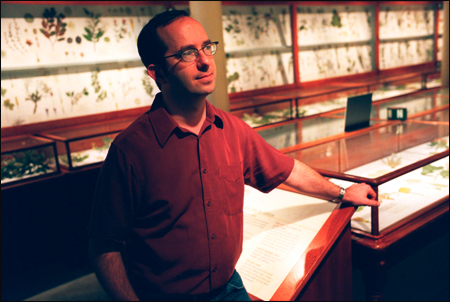Harvard researchers push human cereal use back 10,000 years
Findings on small grain grasses support theory of agriculture’s rise

A 23,000-year-old hunter-gatherers’ camp submerged under the Sea of Galilee for millennia has provided Harvard researchers with new information about early human diets, showing that grains were staple foods 10,000 years earlier than previously thought and shedding new light on agriculture’s roots.
The site, called Ohalo II, was discovered in 1989 after water levels dropped dramatically as a result of severe drought coupled with increased pumping for human use.
The site’s remains were preserved under the lake’s waters and included plant materials, which unlike stone or bone are rarely recovered from periods as long ago as 23,000 years.
The anaerobic underwater environment inhibited decomposition of the plant remains, leaving a rare record of the Upper Paleolithic diet – some 90,000 plant remains – for Harvard Postdoctoral Fellow in Anthropology Ehud Weiss to read.
Along with Wilma Wetterstrom, associate in botany at the Harvard University Herbaria, Anthropology Professor Ofer Bar Yosef, and a colleague from the University of Haifa, Weiss found new insights into human exploitation of plants and the origins of agriculture.
At Ohalo II, grass seeds were the principal plant food, augmented by a wide variety of other wild foods, including acorns, almonds, pistachios, olives, raspberries, figs, and grapes.
“The site shows us that the plant-human relationship that was part of the beginnings of agriculture was not a short one,” Weiss said. “It was a long association.”
A variety of animal remains was also found at the site, including those of mammals, fish, birds, and mollusks; these remains are being analyzed separately.
Among the 19,000 grass seeds found were a significant number of wild wheat and barley seeds. While this pushes wild cereal use back much earlier than previously known, Weiss said the discovery of significant cereal use was not very surprising because these plants are dominant foods found at later sites. Wild wheat and barley were eventually domesticated and are among our major cereals today.
More remarkable was the vast quantity of seeds from small-grained grasses, the first evidence that people had relied extensively on this food source and an indication that the camp’s occupants ate a far more diverse array of grasses than previously thought.
“It was really a shotgun approach,” Wetterstrom said. “They were collecting as much as they could.”
Not only were the Ohalo II people gathering a broad range of grains, but they were also reaching out to foods with smaller returns for the labor. The small-grained grasses, far tinier than the cereal, grew on shorter plants that demanded more stooping and bending to harvest than wild wheat and barley. Separating the grain from the husks was an arduous chore for all the grasses, but the yield for the amount of work was far less for the small-grained grasses because of their minute size.
These grass seeds were so tiny that, though there were far more of them – 16,000 versus 2,600 cereal grains – the small-grained grasses still made up just 35 percent of the grass seed volume.
That this labor-intensive food was present in significant quantity at Ohalo II provides the first evidence that a prevailing theory about the rise of agriculture, which has already been validated for animals, may be true for plants as well, the researchers said.
“This is the first proof that the broad spectrum hypothesis applies to plants as well as to animals,” Wetterstrom said.
The theory holds that with changing climactic conditions and increasing human population, the few primary foods of early hunter-gatherers were no longer adequate to sustain them.
In response, Paleolithic people began hunting and gathering a much broader range of foods, including what would be considered far less desirable choices because of the labor involved in their capture versus the amount of food they yielded.
Called by scientists the “broad spectrum revolution,” this development ultimately led to domestication of plants and animals and the development of agriculture. Hunter-gatherers, casting their nets farther for food, began using the plants and animals that they eventually farmed and herded.
Though evidence of this dietary expansion has been found among animal remains as far back as 50,000 years, until now there has been no evidence that early humans broadened their plant diet as well, mainly due to the scarcity of preserved plant remains.
“It is similar today to people who need to support their family and get a second job, one that doesn’t pay nearly as well as the first but adds some income,” Weiss said. “I think that is what these people did, get a second job gathering small-grained grasses.”
The Ohalo II site was occupied during the height of the last Ice Age, called the Last Glacial Maximum. With a lot of fresh water frozen in the glaciers, the climate at Ohalo II was much cooler and drier than today, perhaps decreasing the abundance of natural foods and forcing inhabitants to gather smaller grass seeds to augment other items in their diet.
Excavated from 1989 to 1991 and again from 1999 to 2001, the site itself is a collection of the remains of several small huts, fireplaces, a human grave, and stone tools spread across 2,000 square meters. Among the tools found was a grinding stone in the remains of one hut, with both small-grained grasses and larger cereal grains found around it.
“Before Ohalo II, I didn’t think we’d have such a window on hunter-gatherers who lived in such an area,” Weiss said. “This is part of the reason we’re in the research business, finding out things we never thought possible.”




